The Abandon Videos
This is an odd time to be thinking about a dead leaf. Our songbird neighbors are turning up the volume and, in his impatience for love, our local skunk, normally a nocturnal fellow, has been scrambling up the hillside before sunset. Spring is upon us. Yet here I sit, absorbed in a video of a yellowed leaf, spotted with age, pirouetting in the breeze.
It is the humility of Abandon I, as artist Gail Wight titled her 2011 video, that gets me. There is nothing remarkable about her subject. If I looked out the window, I might see such a leaf. There are always dead ones around, despite the greening time of year. And it is not uncommon to see a leaf caught, as Wight’s subject was caught, by a bit of spider web, dangling in midair.
What is uncommon is the way Wight sees this leaf, and makes me see it, as a bit of life passionately, even exuberantly, absorbed in living, despite its imminent dissolution. It’s a matter of focus and of framing—she blurs the leaf’s home tree into a scintillating backdrop, using its trunk as a proscenium, framing a stage in the volume of air beneath the hanging limbs.
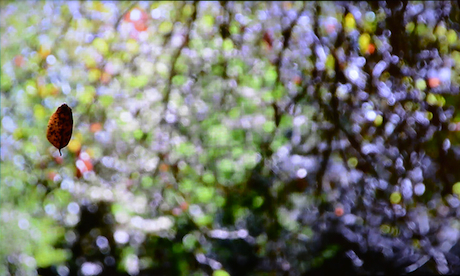
Abandon I (2011)
HD video, runtime 5′
Within that visual space, the leaf is suspended en pointe by the invisible silk. Animated by the breeze, it hovers, flits, and spins, exploring the space like a ballerina. At one point it chassés along the edge of the frame, as if gathering force for a leap through the screen. One knows that the leaf, cut off from its tree, is dying, yet in the moment it seems emphatically, poignantly, alive.
Why Gail Wight?
Someone who can put across pathos, courage, and joy in the way she looks at a dead leaf gets my vote as an important artist. Wight has been earning my vote now for fifteen years, since I first encountered her work. A post or two ago I spoke of the pleasures of knowing a work of art deeply, establishing a relationship with a piece by returning to it over time. There is the same pleasure, multiplied, in following the work of a living artist. Just as with all relationships, the chemistry of a relationship between an oeuvre and a viewer is unpredictable. But if you are lucky enough to encounter a living artist whose fascinations mirror your own, it would be just as sad to loose track of their work as it would be to lose a friend with whom you can really talk.
So I take a move in Wight’s work seriously. Abandon I and its companion Abandon II (also a naturally suspended leaf), made me wonder if Wight, who Nature called “an artist of science,” is entering a new phase. This is a big question; Wight is a prolific, inventive artist and her work has covered a lot of ground. But although her methods are varied, her themes have consistently centered on “natural philosophy,” as the pursuits we call “science” were once known. The Abandon series is not overtly related to science. But, in the overall scheme of Wight’s work, is it a trend, a departure, or a variation?
Beautiful molds, spiders on drugs, and currents in the air
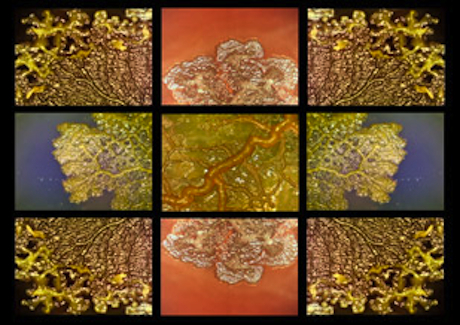
Hydraphilia (2009)
Time-lapse video, 9 monitors, dimensions variable, ~12 min. loop
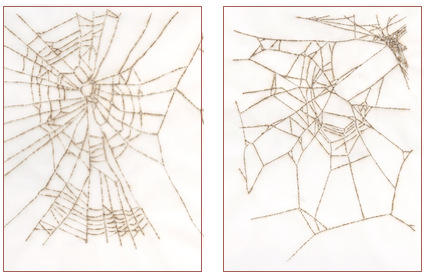
Solar Burn: Benzedrine (2011) (left)
Solar Burn: Caffeine (2011) (right)
Each work: burned vellum, 18″ x 15″
In 2011, the same year as Abandon, Wight made the marvelous Solar Burn series based on drawings by a pharmacist who fed spiders psychotropic substances, then recorded the webs they spun. Wight copied his drawings by burning tiny holes in vellum with a magnifying glass. From a distance, the crazed webs—no question, the drugs disrupted the patterns of spider “thought”—look like delicate sepia drawings. But they sparkled like no ink drawing on Earth when they were installed on the glass of a University of California Botanic Garden greenhouse for the exhibition Natural Discourse. Sun seeped through the translucent vellum and refracted around the burn rims; the drawing became light.
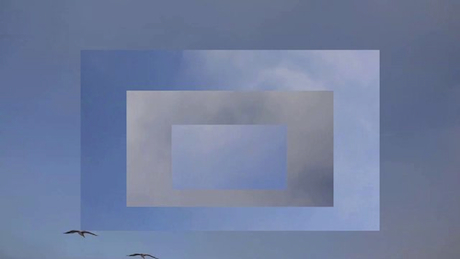
Homage to the Wind (After Albers) (2012)
HD video, dimensions variable
The most recent work on Wight’s website is a 2012 video series, Homage to the Wind (after Albers). She composited video from five types of outdoor settings—blue skies, wheat fields, ocean waves, tide pools, and forests—into the nested format that served Joseph Albers so well in his famous Homage to the Square series. (According to the Metropolitan Museum website, that series includes more than a thousand works executed over a period of twenty-five years starting in 1950.)
Like Albers’ works, Wight’s videos are without incident. Occasionally a bird passes, that is all. Strange things happen, anyway. A cloud glides through, turning the central sky white, and the next tier of sky suddenly darkens. A wave crashes, seemingly splashing into the next space, although the video edge is sharp, the breach illusory. The work is about the excitement of seeing, not the seeing of excitement.
What slips away and what remains
Put Wight’s recent works together and what do we have? A significant turn, I would say. Compare the Solar Burn series to Passing Through, a 1994 book in which Wight also drew with a magnifying glass.
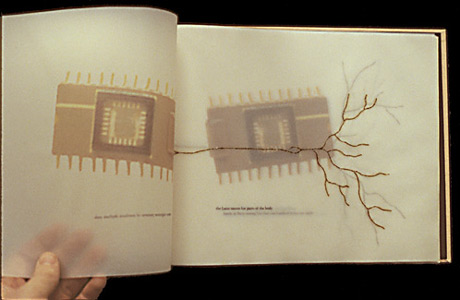
Passing Through (1994)
vellum, hand bound
edition of 33; 9″ x 13″ x 1/4″. 18 pp.
Or consider Homage to the Wind and Abandon II in tandem with the 2000 video sculpture Future Flight. Wight describes the latter this way: “Drawings on a chalkboard illustrate a century of mutations on the fruit fly drosophila. On one inset monitor, two fruit flies are involved in a mating dance. On the other, a biochemist offers them genetic counseling.”
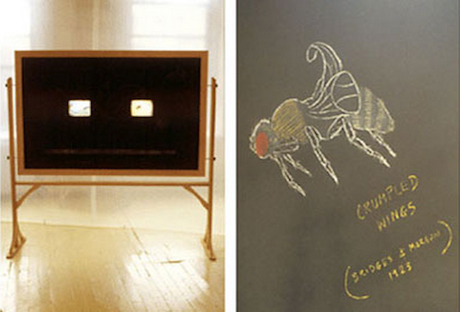
Future Flight (2000)
wood, blackboard, chalk drawings, video and sound
78″ x 72″ x 24″
Future Flight is a wonderful piece, droll in its humor and pointed in its commentary. It helps to be aware that the species Drosophila, needing just a bit of fruit and water to survive and having a fast turnaround time for breeding, was the work animal of early 20th century genetics. Before there were electron microscopes and genetically engineered mice, there were scientists with a lot of patience for counting insects and flies with mutations produced the old fashioned way, through selective breeding, radiation, and the occasional chemical. The kooky act of counseling these flies images both human anxieties about genetic manipulation and concern for the natural world, without attacking the scientists, who after all were attempting to better the lot of humans.
In their generous outlook, the more recent works are of a piece with Future Flight. Yet on the whole, Wight’s use of narrative has become more subdued. Yes, there is scientific history in Solar Burn and art history in Homage to the Wind. But one could “get” them, I think, without access to the historical narrative, and in the Abandon videos, the story has boiled entirely away, leaving a sediment of emotion. The particulars of the leaf’s story, the particulars of the human stories it might represent, are abandoned, in surrender to the enthralling “now.”
Why should you care?
I hope I’ve made you a little curious about Wight’s work; it deserves attention. There is so much more to say about it than could fit in one report. But even more, I hope I’ve made you think about the artist with whom you would like to have a long-term relationship, whether you know who they are or are still looking for them. Whoever they are, they can give you something that mass-produced culture, no matter how powerful, can never give: detailed, personal, idiosyncratic contact with another individual picking his or her own way through our times. I’ve been slow to write about Wight’s work, despite my admiration for it, because I kept finding more depths in it, more to ponder. Then I realized THAT was the story. I don’t have to come to a grand conclusion about Wight’s work to be touched by the ways it moves and changes; I just have to keep track of it, pay attention, and things will be revealed. My wish for you, dear reader, is that you, too, will find an artist with whom you want to experience this process.
Gail Wight’s website
Video: excerpt from Abandon
Video: excerpt from Homage to the Wind (after Albers)
